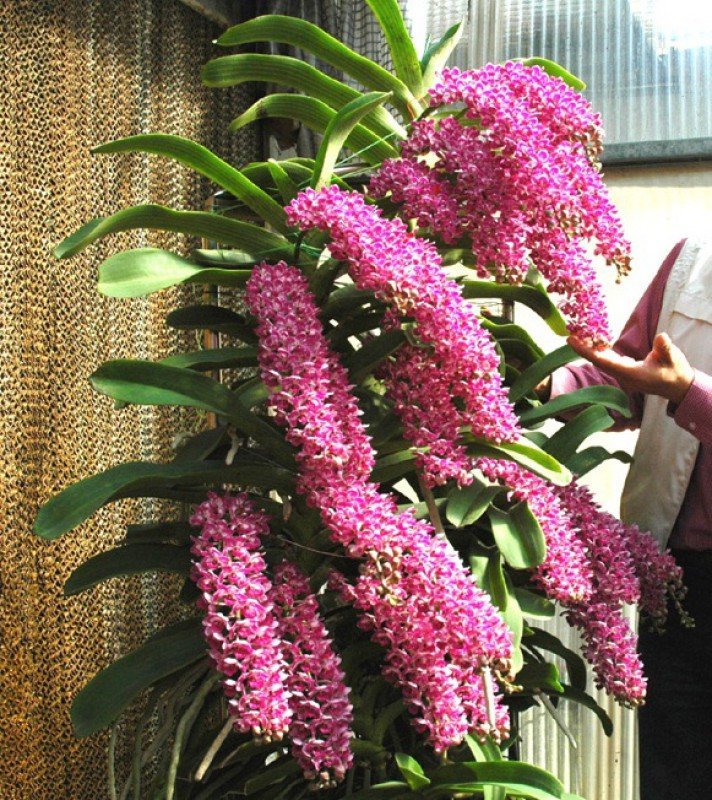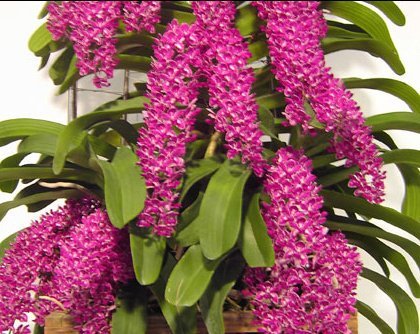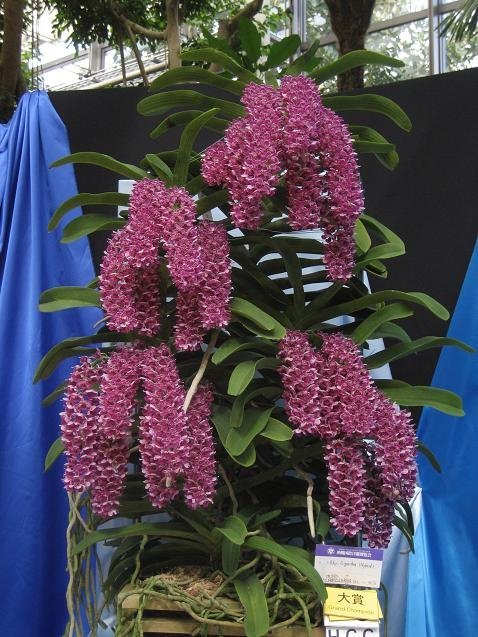We have been growing and importing Rhynchostylis gigantea for 20 years and it remains a rewarding plant. The plant is strong, blooms profusely and produces a wonderful fragrance. The older and larger the plant gets, the more flowers appear. Artificial pollination has expanded the colors of this plant to orange, red and peachy. Rhynchostylis gigantea is native to Myanmar, Thailand, Malaysia, Laos, Cambodia, Vietnam, China, Borneo and Indonesia.
Characteristics and appearance.
The Rhynchostylis orchid has typical Vanda qualities. It is a monopodial plant (growing from a single point) with leathery leaves arranged in opposite directions. The plant has silver-green roots with a thick outer layer and blooms in hanging clusters.
Growth habit
It is a medium-sized, warm-growing epiphyte. This means it grows on branches and trees, not in the ground. It grows up to 60 cm tall, with a strong and thick stem forming at the base. The leaves are up to 30 cm long and 5-7.5 cm wide.
Flowers
Rhynchostylis gigantea flowers grow in clusters up to 37 cm long. The sweet-smelling flowers persist for about two weeks. The flowers are 2.5-3 in diameter,8 cm. They are mostly white, with reddish purple, amethyst purple or crimson spots and often have a clearly visible spike of the same color. The lip is also reddish purple, amethyst purple or crimson and usually fades to a white color at the base and toward the center. Varieties with white flowers have also been found, and occasionally you will find specimens with red flowers.
Care
Sunlight
This plant likes sunlight, but not direct. Diffuse light is more favorable. Direct afternoon sunlight can be a threat to the plant. The plant likes strong air movement around the roots.
Temperature
It is a thermophilic plant, so it likes heat. The plant may well stand a little cooler, but then you must be careful with watering. The plant is less likely to dry out. The temperature during the day is 21.5-33 degrees Celsius and at night 18.5-25 degrees Celsius. In spring it can be a little warmer, around 24-35 degrees Celcius. In winter, this plant also needs a warm temperature, around 21.5-33 degrees Celcius.
Humidity
Rhynchostylis gigantea needs a humidity of around 80% for most of the year, reduced to around 70-75% in winter and early spring. At low temperatures (21 degrees Celcius), humidity can be reduced to 40-70%.
This applies to plants in a pot culture. The humidity in substrate is higher. The part above ground needs less water and the heart of the plant stays dry, which helps prevent rotting. The part below ground needs more moisture and can absorb more water. The substrate holds the moisture more, while hanging plants dry out faster and therefore need higher humidity.
Watering
Rainfall in the natural environment varies from abundant to very abundant. Rain showers begin in late spring and last until autumn. Then the drying season begins fairly quickly, lasting 3-4 months (winter and early spring). Cultivated plants should be watered abundantly during the growing period, but then air flow around the roots should be ensured so that they can dry quickly after watering. In the case of plants growing in pots or baskets, the substrate used should not get wet.
Placement
Rhynchostylis gigantea grows best when several aerial roots can hang loosely. You can place the plant in wooden baskets without adding substrate or attach the plant to tree ferns or cork without substrate around the roots. Under these conditions, ensure high humidity and water the plants at least once a day and even several times a day on hot and dry days.
Substrate
They can also be grown in pots with very loose, quick-drying soil, allowing the roots to dry quickly after watering. Good results are obtained with a mixture of equal parts of medium and large pieces of spruce bark and charcoal. You can use only charcoal as a substrate.
Repot
These plants react unfavorably to repotting. But if the plants are growing in pots filled with a mixture of bark, they should be repotted every year, because a possible breakdown of the bark can quickly lead to the death of the root system. The plant should be planted very shallow. Plants adapt faster and with less stress if they are fixed or repotted at the stage when new roots are just beginning to grow.
Fertilization
During the active growing period, plants should be enriched weekly with orchid fertilizer. You can use sustainable fertilizers all year round, or you can use fertilizers with increased nitrogen content from spring to mid-summer. And in late summer and fall, you can use fertilizer enriched with phosphorus.
Rest period
Rhynchostylis gigantea needs much less water in winter. If the humidity is high in winter, sporadic spraying of the plants and occasional watering should provide enough moisture for proper development. If humidity is low, the plants should be watered more frequently. These plants should never be allowed to dry out completely. Fertilization should be reduced or eliminated altogether until spring.





